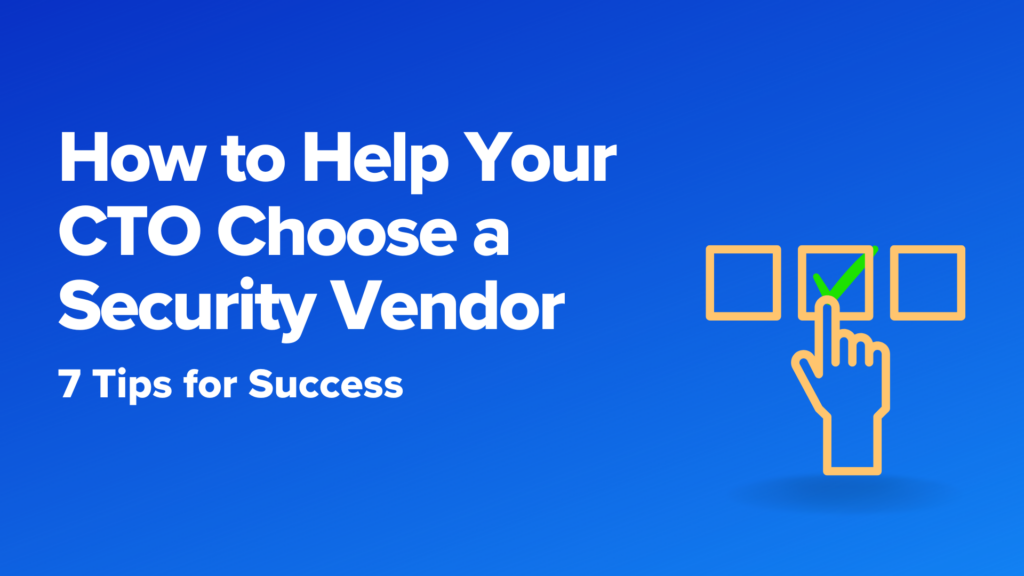When you’re going through the security vendor selection process, there are multiple stakeholders that need to get onboard: the relevant security teams, IT teams, the end users, company leadership. Yet, one key decision maker who may be overlooked is the CTO.
While the CTO is usually not responsible for security, their tech teams, support or IT teams, may be the ones who will implement, maintain, manage and support the solution.
(We say “CTO”, but it really depends on the company. In some companies this person could be the CIO, or even the CEO. For simplicity purposes we will continue to use “CTO”, but the tips here can be applied to the C-suite person in charge of security tool deployment and support).
But the CTO (or CIO, etc.) has multiple responsibilities on their plate. They are busy overseeing the company’s technical vision and ensuring its seamless execution. Balancing long-term strategy with daily operations, they focus on evaluating new technologies, managing development teams and more. This means their day is filled with back-to-back meetings, critical reviews and firefighting urgent issues. This hectic schedule means that their time and attention are a rare and valuable commodity.
Security teams who bring security vendors to the CTO’s review and approval need to consider their constraints and needs. In this article, we provide tried and true tips for bringing your CTO on board to the tools you’d like to deploy. By following these tips, you will be a few steps closer to implementing and using the security tools you believe are the best choice for your organization’s security and business needs.
1. Align Business, Security, and Technology Goals
In an organization, everyone has the same goal – business success. Yet, sometimes different stakeholders and departments have competing objectives. One of the primary challenges CTOs face is bridging the gap between ROI and tech. And while security’s importance is evident, it’s important to clearly show how the chosen security solution can serve all three aspects (the business, tech and security) effectively.
This is a complex endeavor. Doing so starts with developing a comprehensive document that outlines how business goals, security requirements and technology initiatives intersect. Then, when presenting security vendor options to your CTO, clearly demonstrate how each aligns with the organization’s overall objectives.
For example, imagine your company’s primary business goal is to expand into new international markets. In this case, you’d want to prioritize security vendors that enable fast remote connectivity and data security while offering robust compliance features for various global regulations. This alignment ensures that the chosen security solution not only protects your data but also enables the tech team to deliver positive customer experiences and facilitate business growth.
Or, your business might need to enable BYOD workforces to bring in global talent, enable flexibility to work with contractors and drive productivity through employee satisfaction. In this case, you will need a security solution that was designed for BYOD workforces. By enabling employees to work on apps on their local device without VDI complexity, you can free up your tech team so they can work on strategic initiatives rather than dealing with frustrated remote users’ tickets when they experience VDI lags.
2. Choose Solutions That are Easy for the Tech Team to Manage
CTOs are often responsible for supporting the organization’s departments by overseeing the tools they use. Each tool is different, requiring different expertise and serving different users. This juggling and contextual switching makes tool support a headache. If the headache is too heavy to manage, the CTO might prevent new tools from being brought in. Therefore, you want your tool to be the IT team’s favorite. To do so, it’s important to consider the manageability of the solution from the tech team’s perspective.
How to help:
- Choose solutions that are easy to deploy: Shorten implementation times by bringing solutions that employees can deploy in a few clicks, relieving the deployment burden from IT.
- Find solutions that don’t require day-to-day maintenance: Some solutions have a complex backend to manage, like VDIs. Look for vendors that do the heavy lifting themselves so IT teams don’t have to figure it out themselves.
- Prioritize user-friendly solutions: Look for security solutions that provide a good end-user experience, which will be easy for employees to use and will relieve firefighting from IT.
- Consider integration capabilities: Choose vendors whose products can seamlessly integrate with your existing tech stack.
- Evaluate support and training options: Opt for vendors that offer comprehensive support and training resources for your tech team.
By choosing solutions that are straightforward for the tech team to implement and maintain, you’re freeing up valuable time and resources. This allows the CTO and their teams to focus on broader strategic initiatives rather than getting bogged down in the day-to-day management of complex security systems.
3. Provide Comprehensive and Concise Information
CTOs need detailed information to make informed strategic decisions, but they often lack the time to conduct extensive research themselves. When evaluating potential security vendors, it’s recommended to gather and present relevant information for the CTO in a way that is both comprehensive and easily digestible.
How to help:
- Create vendor sheets: Highlight key features, pricing, how the solution aligns with your organization’s needs, and cybersecurity vendor comparisons to other solutions with clear cybersecurity vendor selection criteria.
- Record and summarize discovery calls: If you’re on discovery calls with vendors, record the sessions (with permission) and create concise summaries for your CTO.
- Compile relevant documentation: Gather user manuals, whitepapers and case studies from potential vendors and organize them in an easily accessible format.
- Prepare for questions: Anticipate questions your CTO might have and have answers ready, including technical specifications, implementation timelines and potential ROI.
For example, when presenting information about a new BYOD security solution, you might create a one-page summary that includes:
- Key features and how they address your specific security needs
- Implementation timeline
- Resource requirements
- IT and support team requirements
- Customer reviews and industry ratings
- Pricing structure and how it fits within your budget
- Potential impact on system performance
By providing this level of detailed yet concise information in a structured format, you’re enabling your CTO to make faster, more informed decisions in the security vendor selection process without having to sift through overwhelming amounts of data.
4. Don’t Bog Their Schedule with Meetings
Time is a precious commodity for CTOs, and their schedules are often packed with strategic planning sessions, team meetings and crisis management. Respect your CTO’s time by minimizing unnecessary meetings and maximizing the efficiency of the ones that are truly needed.
How to help:
- Conduct initial screenings and narrow down to the top 3-5 options.
- Create a detailed comparison document for these finalists.
- Schedule one focused meeting with the CTO to review the options and make a decision.
5. Promote a Culture of Cybersecurity Awareness
CTOs who have a deep understanding of cybersecurity will naturally be more inclined to invest in managing and supporting security tools. They will also find it easier to make informed decisions about new vendors.
Creating a culture of cybersecurity awareness by can be done in a few ways:
- Ongoing security training
- Sharing relevant news and updates
- Spotlighting new vendors and capabilities
- Gamifying security with competitions, rewards and recognition programs
- Developing easy-to-follow guidelines for security practices like data handling, password management and incident reporting
For instance, you could implement a monthly “Security Spotlight” email that highlights a different security topic each time, provides tips for best practices, and maybe even includes a quick quiz with prizes for participation. This not only educates employees but also keeps security top-of-mind across the organization.
By fostering a culture where cybersecurity is everyone’s responsibility, you reduce the burden on the CTO to engage with the support team on the need to manage and maintain security solutions, making the decision to implement new solutions you need much easier.
6. Hire or Appoint a Technical Operations Lead
CTOs have multiple responsibilities, from strategic planning to evaluations to communication to management. Help them help you by reducing the tasks related to a new security solution. Appoint a security point of contact who can bring the tech support and IT team on board, answer questions and liaison with the vendor on any requirements, making the IT team’s onboarding smooth and efficient.
7. Ask Them What They Need to Make a Decision
While it’s important to anticipate your CTO’s needs, sometimes the most effective approach is simply to ask them directly what they require to make an informed decision about a new security vendor. This is because different CTOs have different needs and requirements, and because roles and responsibilities vary between organizations.
How to help:
- Schedule a brief planning meeting: Before diving into the security vendor selection process, have a short session with your CTO to understand their preferences and requirements.
- Create a decision-making checklist: Based on their input, develop a checklist of criteria that need to be met before presenting final options.
- Establish a preferred communication method: Determine how your CTO prefers to receive updates and information throughout the process: channels and formats.
- Set clear expectations: Agree on timelines, budget constraints and key decision points in advance.
- Get their voice heard: Ask them which questions to ask during a security vendor demo so they get the answers they need
Summary
Remember, the goal is not just to choose a vendor, but to select a security solution that aligns with your organization’s objectives, integrates smoothly with your existing infrastructure, and ultimately strengthens your overall security posture. By making your CTO’s job easier in this security vendor selection process, you’re contributing to more efficient decision-making and a more secure, technologically advanced organization.
If you’re looking for a BYOD security solution for your CTO to approve, take a look at Venn.
Venn is revolutionizing how businesses enable BYOD workforces, removing the burden of buying and securing laptops or dealing with virtual desktops. Our patented technology provides companies with a new approach to securing remote employees and contractors working on unmanaged computers.
Venn’s Blue Border™ is similar to an MDM solution, but for laptops. Work lives in a company-controlled Secure Enclave installed on the user’s computer, where all data is encrypted and access is managed. Work applications run locally within the Enclave – visually indicated by the Blue Border – isolating and protecting business activity from any personal use on the same computer. Company data is secured without controlling the entire device while ensuring end-user privacy for everything outside the Blue Border. As a result, IT teams can easily support BYOD workforces without the cost, complexity, and usability challenges of VDI.
Over 700 organizations, including Fidelity, Guardian, and Voya, trust Venn to meet FINRA, SEC, NAIC, and SOC 2 standards. Learn more at venn.com.



